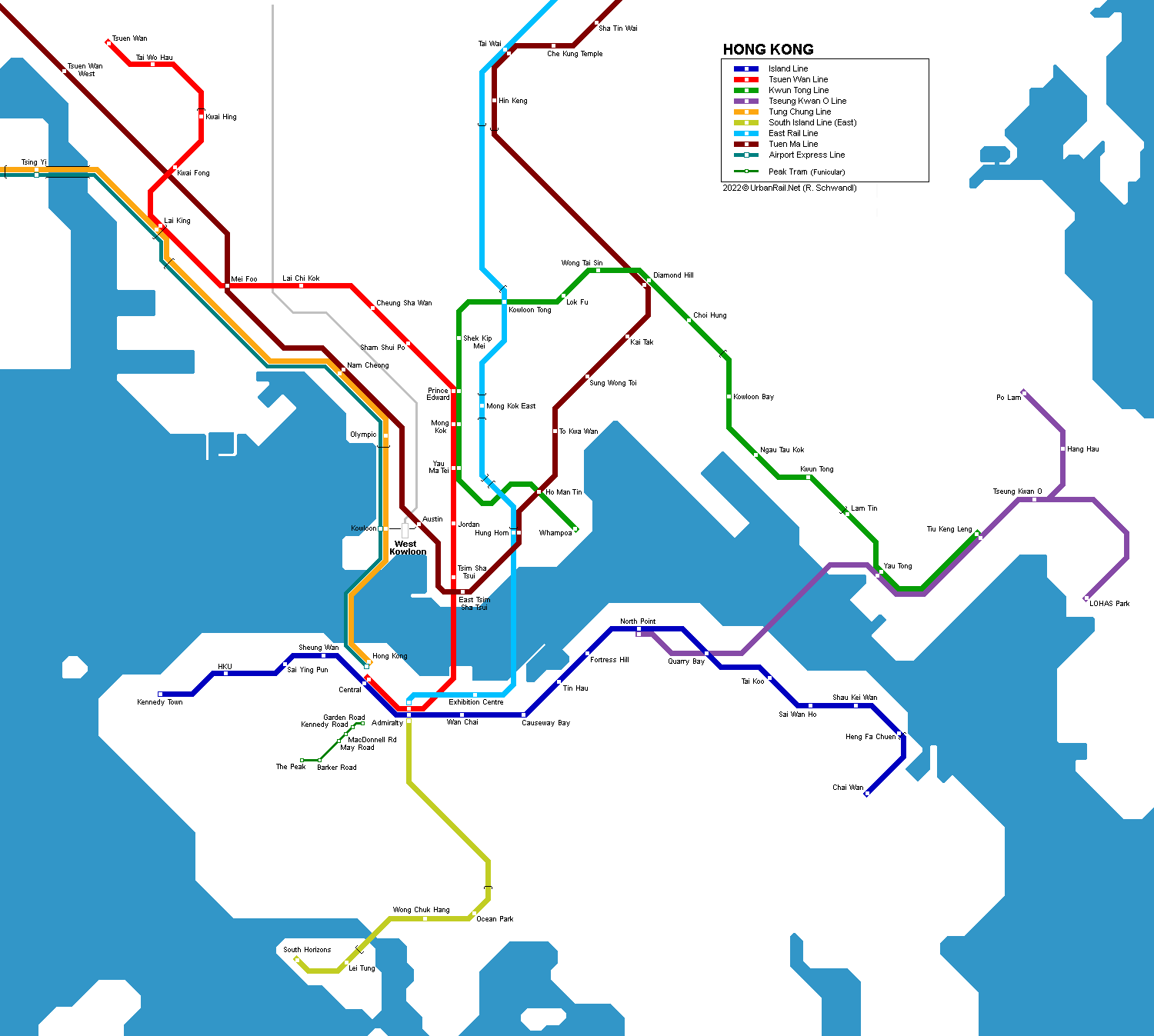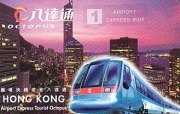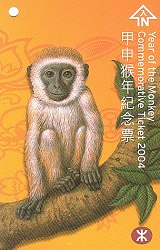|
[ UrbanRail.Net ] [ Europe ] [ Americas ] [ Asia ] [ Africa ] [ Oceania ] [ News ] [ Books ] [ Links ] |
|
HONG
KONG
|
| China |

|
[ UrbanRail.Net ] [ Europe ] [ Americas ] [ Asia ] [ Africa ] [ Oceania ] [ News ] [ Books ] [ Links ] |
|
HONG
KONG
|
| China |

|
|
|||
| MTR Lines | |||
| Kwun Tong Line |
|||
|
Tiu Keng Leng – Whampoa: 18.8 km – 17 stations Opened in 1979 as the Modified Initial System (MIS), the Kwun Tong Line is the first metro opening to the public in Greater China (Beijing Subway was officially “under testing” until 1980s). The line used to cross the harbour, but was replaced by the Tsuen Wan Line in 1982 and the Tseung Kwan O Line in 2002. The crowded urban environment of Hong Kong may be experienced when travelling along the viaducts from Kowloon Bay to Lam Tin, showing the interlocking road structures and grade-separation measures. In 2016, the line was extended to Whampoa via Ho Man Tin, providing the large residential development with a railway service. However, the line is only single-track between Ho Man Tin and Whampoa, making Whampoa only getting half the entire line's frequency. |
|||
|
|
|||
| Tsuen Wan Line | |||
|
Tsuen Wan – Central: 16.9 km – 16 stations The Tsuen Wan Line opened as the Tsuen Wan Extension in 1982, serving the satellite city of Tsuen Wan and the major corridor along Cheung Sha Wan Road and Nathan Road, with its passengers including those who transferred from road traffic from the New Territories towns, leading to overcrowding before the completion of Tung Chung Line in the late 1990s. The line is constantly crowded, being the link between major commercial centres of Mong Kok, Tsim Sha Tsui and the Central District. |
|||
|
|
|||
| Island Line |
|||
|
Kennedy Town – Chai Wan: 16.3 km – 17 stations The Island Line was thought to be able to replace the tram on Hong Kong Island when planned, and is unique in most of its stations being constructed in tunnel bores, with smaller platforms and curving-in walls creating a claustrophobic environment. MTR mitigated by putting large calligraphy reproductions of the station names on the walls, with such names becoming an artistic feature not found on other urban lines. Its former western terminus, Sheung Wan, had a section of a platform built to accommodate the East Kowloon Line, which has since been refilled and reconstructed as passageways to prepare for the extension to the Western District after the plans for the East Kowloon Line had been shelved and modified. |
|||
|
|
|||
| Tung Chung Line |
|||
|
Tung Chung – Hong Kong: 31.1 km – 8 stations The Airport Express and Tung Chung Line are collectively known as the Airport Railway, linking the city with the Airport and its supporting new town of Tung Chung since 1998. The two lines share tracks on the Tsing Ma Bridge and when crossing the harbour. The railway proved to be a crucial link of the Lantau Island in adverse weather, being the only form of transportation available when the highway was once unexpectedly flooded and blocked due to landslides. The cross-platform interchange with Tsuen Wan Line at Lai King proved to be effective in transferring the load of the Tsuen Wan Line to a faster corridor, leaving the capacity for the Nathan Road corridor. |
|||
|
|
|||
| Disneyland Resort Line |
|||
|
Sunny Bay – Disneyland Resort: 3.5 km – 2 stations Originally called the Penny’s Bay Rail Link, the Disneyland Resort Line is the first fully automated heavy-rail line in Hong Kong and the world’s first dedicated railway for a Disneyland Resort, opening in 2005 before the opening of Hong Kong Disneyland Resort. Trains were refurbished and redesigned to a Disney theme to provide passengers with the experience akin to the theme park. |
|||
|
|
|||
| ... | |||
| Tseung Kwan O Line |
|||
|
Po Lam / LOHAS Park – Quarry Bay: 15.5 km – 8 stations The Tseung Kwan O Line utilises a reserved corridor in the middle of the new town to provide convenient access for the high-density developments surrounding the stations. The planning of the town is based on the idea that the stations should be within walking distance of the residents. The depot of the line at Tseung Kwan O South is combined with housing developments on top in a similar manner as the other depots for the urban lines. This form of residential development is how the railway company was able to finance its lines and provide the supporting passenger base at the same time. The branch to LOHAS Park only offers direct trains to North Point during peak hour, while off-peak there is a shuttle service from LOHAS Park to Tiu Keng Leng for transfer. |
|||
| East Rail |
|||
|
Lo Wu / Lok Ma Chau – Hung Hom: 46 km – 16 stations The original Kowloon Canton Railway, a railway that connects to China and beyond, formed a substantial part of the present East Rail Line service. The railway was steam and later diesel-powered in its early years, being an intercity long-distance railway. It began its commuter rail service in 1983 after electrification and double-tracking, becoming the spine of the transport system of new towns in East New Territories. Modernisation of the fleet in 1998 marked the transformation of the KCRC into a metro operator in anticipation of the completion of the West Rail. The railway returned to Tsim Sha Tsui, the place where the railway began in 1910, briefly before the opening of the Kowloon Southern Link when the West Rail was extended to Hung Hom. In 2022, the East Rail was extended across the harbour to Admiralty, forming a North-South corridor that connects the border to the Central Business District of Hong Kong. |
|||
|
|
|||
| Tuen Ma Line |
|||
|
Tuen Mun South – Wu Kai Sha: 57 km, 27 stations (former)
West Rail: Tuen Mun – Hung Hom: ~35 km – 12 stations The northwestern New Territories was not served by the metro system until the opening of the West Rail in 2003. The line is characterised by its long viaduct sections in flood-prone areas and by its large stations. The Pat Heung Depot was the largest of its kind in Southeast Asia when it opened. The Northern Link is a long term extension of the West Rail to the border, potentially alleviating the crowds on East Rail and diverting the increased patronage from new developments in the area. The former Ma On Shan Line was built as a spur line of the East Rail to serve the eastern portion of the Sha Tin–Ma On Shan New Town. The stations are closely connected to the population centres of the town in the same manner as the Tseung Kwan O Line, both being planned together with the new towns, thus the line was dubbed the “community railway”. The line is being extended to connect with the West Rail through eastern Kowloon Peninsula, replacing the alignment and function of the former East Kowloon Line, forming the East-West Corridor from Wu Kai Sha to Tuen Mun and being renamed Tuen Ma Line. In mid-2021, the former West Rail and Ma On Sha Line were eventually connected at Hung Hom and West Rail was fully integrated into what had become the Tuen Ma Line.
|
|||
|
|
|||
| Airport Express |
|||
|
Hong Kong – AsiaWorld-Expo: 35.3 km – 5 stations The Airport Express operates at the top speed of 135 km/h, linking the city centre at Central to the Airport in just 24 minutes. In-city Check-in Service is available at Hong Kong and Kowloon stations, with the luggage loaded onto the carriage at the Hong Kong end of the train specially designed for the service. The trains are technically identical to the trains on the Tung Chung Line, but were specially designed for comfort in long-distance travel. Special fares are available when there are exhibitions and performances at AsiaWorld-Expo to cater for the huge crowds from elsewhere in the city. Tung Chung Line trains will also occasionally go to that station during such events. |
|||
|
|
|||
| South Island Line |
|||
|
Admiralty - South Horizons: 7 km - 5 stations Driverless line opened 28 Dec 2016, operated with 3-car trains, linking the Southern District to the northern shore of Hong Kong island. The line serves the Ocean Park, a famous local theme park popular among tourists, thus it is expected to be crowded at times and there have been capacity concerns from the community. |
|||
|
|
|||
| Photos | |||
|
|
|||
|
History |
|||
|
1) Mass Transit Railway Corporation Lines: 01/10/1979:
Kwun Tong Line Kwun
Tong - Shek Kip Mei 2) Kowloon-Canton Railway Corporation Lines: 01/10/1910: KCR
(British Section) Kowloon (Tsim Sha Tsui, temporary) – Yaumatei – Shatin
– Tai Po (Tai Po Kau) – Tai Po Market - Fanling 3)
since unification > MTR
Corporation Limited (MTRCL): |
|||
| Projects | |||
|
Click here for project details!
|
|||
| LIGHT RAIL | |||
|
|
|||
| TRAMWAY | |||
|
The tram runs between the East and West of the north shore of the HK Island, along the busiest trunk road of the island, and spans to the Happy Valley Racecourse in a little loop. The system is entirely at grade, and shares roads with common vehicles. It takes 45 mins from Shau Kei Wan to Central (on MTR: 19 mins). There is no air-conditioning yet the fare is very low. Its easily accessible locations, price and open view make it an ideal transport among visitors and budget commuters. View complete map!
- route
length 13 km |
|||
|
|
|||
|
|
|||
| Links | |||
|
MTR
Corporation Ltd (Metro network Official site) MTR
at Wikipedia Interactive Map at ExploreHK UrbanRail.Net > Hong Kong MTR Gallery (by Thomas Schunk, Keith Fielder) |
|||
| Photos | |||
|
Photos © Thomas Schunk (More photos) |
|||


2004 © UrbanRail.Net by Robert Schwandl.